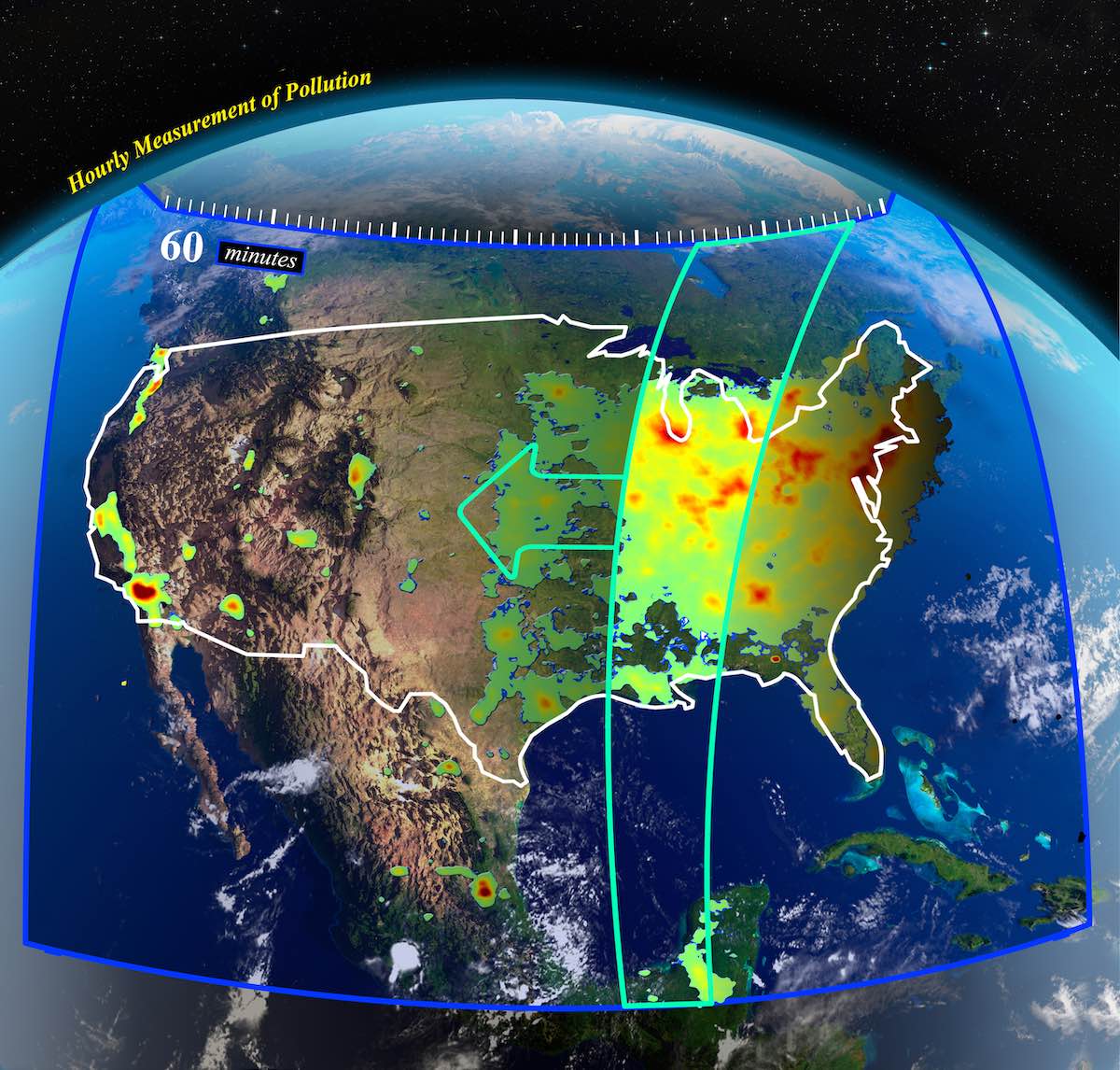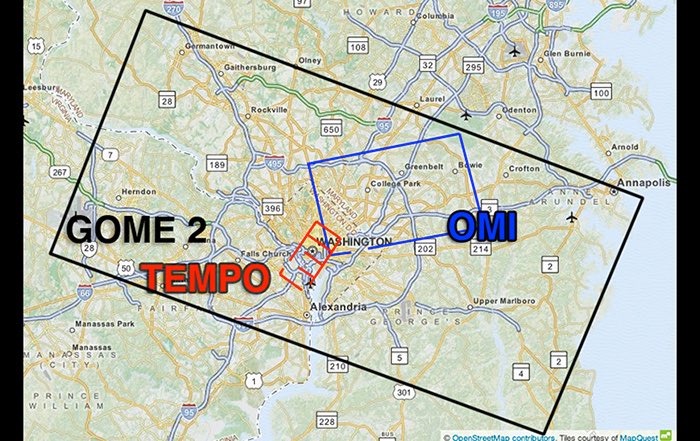Space News & Blog Articles
NASA air quality sensor ready for launch with Intelsat satellite
 Artist’s illustration of the TEMPO instrument’s scan of air quality across North America. Credit: NASA
Artist’s illustration of the TEMPO instrument’s scan of air quality across North America. Credit: NASA
A $210 million NASA mission to improve air pollution monitoring over North America is set to launch Friday with an Intelsat communications satellite blasting off on a SpaceX Falcon 9 rocket from Cape Canaveral.
NASA’s Tropospheric Emissions: Monitoring of Pollution, or TEMPO, instrument is attached to the Intelsat 40e communications satellite for a ride into geostationary orbit more than 22,000 miles (nearly 36,000 kilometers) over the equator. Intelsat 40e will lift off atop a SpaceX Falcon 9 rocket during a nearly two-hour launch window opening at 12:30 a.m. EDT (0430 UTC) Friday.
The TEMPO instrument, about the size of a washing machine, will scan North America to measure pollutants in the atmosphere, collecting data for scientists to study how concentrations of chemicals produced from human activity and natural processes change throughout the day. Forecasters will also use the measurements to predict air quality in cities, which can have significant impacts on human health.
“TEMPO will be measuring pollution and air quality across greater North America on an hourly basis during the daytime, all the way from Puerto Rico up to the tar sands of Canada,” said Kevin Daugherty, TEMPO’s project manager at NASA’s Langley Research Center.
For the first time, scientists will receive air quality measurements multiple times per day once TEMPO begins observations after this year. There are similar instruments monitoring air pollution from satellites in low Earth orbit, but those missions provide just a single observation each day.
Flying in geostationary orbit, Intelsat 40e and TEMPO will circle Earth at the same rate as the planet’s rotation. The orbit gives the satellite, parked over the equator at 91 degrees west longitude, an interrupted view of North America 24 hours a day.
“Every day we can get measurements, say, over New York City at 1:30 in the afternoon, but that’s just one data point over New York over a day, and a lot is happening in New York City over a day. So we have two rush hours that we’re not able to capture,” said Caroline Nowlan, an atmospheric physicist at the Harvard-Smithsonian Center for Astrophysics. “The great thing about TEMPO is that for the first time we’ll be able to make hourly measurements over North America. We’ll be able to see what’s happening over a whole day as long as the sun is up.”
The instrument will be able to measure atmospheric chemistry in pre-selected regional areas as often as every 5 to 10 minutes, scientists said. TEMPO also has improved spatial resolution compared to existing low Earth orbit sensors, with the ability to sample air quality in areas as small as 4 square miles.
“We’re able to, for the first time really, see down to suburban scales or neighborhood scales at hourly resolution,” Nowlan said.
 NASA’s TEMPO instrument integrated on the Intelsat 40e communications satellite at Maxar’s factory in Palo Alto, California. Credit: Maxar
NASA’s TEMPO instrument integrated on the Intelsat 40e communications satellite at Maxar’s factory in Palo Alto, California. Credit: Maxar
TEMPO works by measuring sunlight reflected off particles in Earth’s atmosphere, then splitting the light into different parts of the visible and ultraviolet spectrum. That reveals the chemical fingerprints of atmospheric constituents like nitrogen dioxide, ozone, sulfur dioxide, aerosols, and formaldehyde. The resolution of TEMPO will also reveal emission sources for atmospheric pollutants, such as factories and industrial zones, power plants, large cargo ships, or heavily-trafficked roads during rush hour.
“When we’re burning gasoline or diesel to move ourselves around, or electric generation plants burn coal or natural gas, a byproduct of that activity is nitrogen dioxide, and it’s harmful to human health. it’s a primary pollutant, it’s emitted from a smoke stack,” said Barry Lefer, NASA’s tropospheric composition program manager. “In the atmosphere, it reacts to make ozone and formaldehyde, secondary pollutants which are also harmful to human health.
“So TEMPO is going to give us this ability to track chemical weather as it is emitted from sources, and then transported downwind to other receptor sites,” Lefer said.
“Basically, we have a wide range of chemicals that we measure that let us figure where the pollution is coming from, how it’s being transported and transformed,” said Kelly Chance, TEMPO’s principal investigator from the Smithsonian Astrophysical Observatory. “That data then informs air quality products, hopefully, in near real-time enough, so you can decide whether you can go out for a run today.”
Scientists will also use TEMPO to track pollution caused by wildfires, volcanic eruptions, and industrial-scale farms.
Several hundred organizations, including NOAA and the Environmental Protection Agency, have signed up to use TEMPO data. State and local environmental and health agencies also plan to incorporate TEMPO data into their work.
The TEMPO instrument was built by Ball Aerospace, which developed a nearly identical instrument flying in geostationary orbit on a South Korean weather satellite. That sensor launched in 2020 and is tracking air pollution over the Asia-Pacific region, including China, India, and Japan.
The Sentinel 4 mission will launch in 2024 to provide air quality measurements over Europe, completing a worldwide network monitoring air pollution. The constellation will be able to see how prevailing winds transport pollutants around the globe.
 This illustration compares the higher spatial resolution of the TEMPO air quality instrument with the OMI instrument on NASA’s Aura satellite and the GOME 2 instrument on Europe’s MetOp weather satellites. The Aura and MetOp satellites are in low Earth orbit, while TEMPO will fly in geostationary orbit. Credit: NASA/SAO
This illustration compares the higher spatial resolution of the TEMPO air quality instrument with the OMI instrument on NASA’s Aura satellite and the GOME 2 instrument on Europe’s MetOp weather satellites. The Aura and MetOp satellites are in low Earth orbit, while TEMPO will fly in geostationary orbit. Credit: NASA/SAO
The TEMPO mission won NASA funding in 2012 through the agency’s Earth Venture program, a series of cost-capped satellite missions and instruments with focused scientific objectives.
At the time of its selection, TEMPO was supposed to launch in 2017 as a hosted payload on a commercial satellite. Engineers developing the instrument encountered technical problems that delayed the instrument’s completion until 2018, then managers placed TEMPO into storage for more than a year to find a satellite to host it.
NASA selected Maxar in 2019 to integrate the TEMPO with a geostationary communications satellite it would build for a commercial customer. In 2020, Intelsat joined the mission when it selected Maxar to build the Intelsat 40e communications satellite, which would be positioned in geostationary orbit over the Americas.
Intelsat will relay data and commands between the satellite and TEMPO’s science team at the Smithsonian Astrophysical Observatory in Massachusetts.
Daugherty, TEMPO’s project manager, said the mission has a budget of about $210 million. About $90 million went toward developing the TEMPO instrument itself, and the rest of the budget goes toward paying Intelsat, Maxar, and engineering support contractors for integration and operations.
When NASA selected the TEMPO mission in 2012, hosted payloads had a bright future on commercial geostationary satellites with the promise of offering cost savings for scientific instruments, which would not need to launch on their own spacecraft.
Hosted payloads like TEMPO still have the benefit of lower costs, but the instrument had to wait almost five years from the time Ball Aerospace completed manufacturing until it moved to the launch pad at Cape Canaveral. Matching the schedule for the development of a space science instrument with the faster timelines of commercial satellite procurement proved to be a challenge.
Completing the TEMPO instrument ahead of time allowed NASA to remove uncertainties about the hosted payload’s readiness.
“That process allowed us to come to the table with a fully-completed, fully-tested instrument, which has helped us to fit into the commercial timeline for spacecraft development that moves at a very rapid rate,” Daugherty said.
A NASA laser communications demonstration payload faced similar delays after a commercial host satellite opportunity did not materialize as anticipated. That payload eventually launched in 2021 hosted on a U.S. military satellite. NASA is evaluating lessons learned from the TEMPO experience to improve the process for future hosted payloads on commercial satellites, according to Daugherty.
“The prime reason why there have not been more opportunities is the schedule risk,” said Jean-Luc Froeliger, Intelsat’s senior vice president of space systems. “For a commercial operator, schedule is extremely important. The satellite has to be built quickly, it has to be launched, it has to be in service as fast as possible.”
“In this case we had a rare case where the instrument, TEMPO, was already built when we did the contract with Maxar in early 2020,” Froeliger said. “That risk was retired.”
 Artist’s illustration of the Intelsat 40e satellite in orbit. Credit: Maxar
Artist’s illustration of the Intelsat 40e satellite in orbit. Credit: Maxar
After launching from Cape Canaveral, SpaceX’s Falcon 9 rocket will deploy the 13,582-pound (6,161-kilogram) Intelsat 40e satellite into an elliptical transfer orbit. Intelsat 40e will use its own engine to maneuver into a circular geostationary orbit later this month. Intelsat expects the satellite to begin commercial service by the end of May providing internet service to airplanes and ships.
A protective cover over the TEMPO instrument’s optics will open to allow the sensor to begin collecting atmospheric measurements in July. Scientists calibrate the instrument by comparing its measurements to those collected by airborne and ground-based air quality sensors.
Regular observations with TEMPO are scheduled to begin in October. The mission is approved for 20 months of air quality observations, but TEMPO could continue tracking pollutants for years if the instrument remains healthy. Intelsat 40e is expected to be on station in geostationary orbit for more than 15 years.
NOAA plans to put similar air quality instruments on its next generation of operational geostationary weather satellites due to begin launching in the early 2030s.
“TEMPO will pave the way for the next generation of air quality satellites,” said Xiong Liu, TEMPO’s deputy principal investigator at the Harvard-Smithsonian Center for Astrophysics.
This email address is being protected from spambots. You need JavaScript enabled to view it. the author.
Follow Stephen Clark on Twitter: @StephenClark1.
When you subscribe to the SpaceZE News Feed, we will send you an e-mail when there are new updates on the site so you wouldn't miss them.

